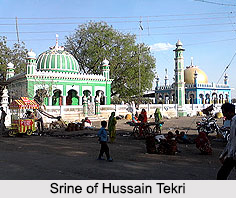 Shrine of Hussain Tekri was constructed by Mohammad Iftikhar Ali Khan Bahadur, who was the Nawab during the 19th century in Ratlam District, Malwa, in the central Indian state of Madhya Pradesh. After his death the Nawab had been laid to rest in the graveyard of Hussain Tekri. Innumerable devotees throng this sacred shrine during Muharram. During the occasion of `Chellum`, numerous pilgrims assemble here to seek shelter from Hazrat Ali Ibn Abu Talib.
Shrine of Hussain Tekri was constructed by Mohammad Iftikhar Ali Khan Bahadur, who was the Nawab during the 19th century in Ratlam District, Malwa, in the central Indian state of Madhya Pradesh. After his death the Nawab had been laid to rest in the graveyard of Hussain Tekri. Innumerable devotees throng this sacred shrine during Muharram. During the occasion of `Chellum`, numerous pilgrims assemble here to seek shelter from Hazrat Ali Ibn Abu Talib.
Shrine of Hussain Tekri as Spiritual Place
The shrine of Hussain Tekri is renowned for the rites of `Hajri` which are regularly performed to heal certain incurable psychological illnesses. The constant work of healing disturbed souls at the shrine of Hussain Tekri has made it the `spiritual hospital of the world`.
The Shrines of Hussain Tekri
The shrines are of Imam Al-Hussain who is Hazrat Ali`s son, Hazrat Al-Abbas, who is another son of Hazrat Ali, the shrine of Hazrat Zaynab who is Hazrat Ali`s daughter, shrine of Hazrat Fatima Al Zehra who is Prophet Mohammed`s daughter, the shrine of Imam Al-Hussain who is the son of Hazrat Ali, the shrine of Imam Al-Hussain, another son of Hazrat Ali, the shrine of Imam Al-Ali, the son of Abu Talib and also the son-in-law of Prophet Mohammed.
Religious Beliefs Regarding Shrine of Hussain Tekri
There is a story, which tells that one night horse riders were seen at the site of the future shrine - and the riders were said to be the souls of martyrs killed in the Battle of Karbala. It is also believed that a water pond was also created overnight, which never existed before. Barelvis, Shia and Hindus visit the shrine to get relief from jinns, ghosts and demons. They believe that all such creatures ultimately surrender before the shrine and leave the bodies of the victims.
Visiting Information to Shrine of Hussain Tekri
The Shrine of Hussain Tekri is located on the Neemach-Mhow Road. It can be reached by either Indore Airport or Ratlam Junction Railway Station (41 km) or Jaora Railway Station (7.5 km). The shrine can also be reached by road via National Highway 19.





















